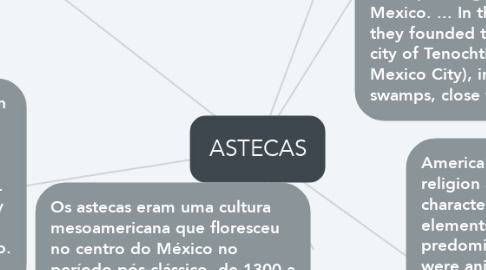ASTECAS
by enzinho sz

1. On August 13, 1521, after the Aztecs resisted for 75 days, the last Aztec emperor, Quatemozin (also called Guatemozin), Montezuma's 2nd successor, was forced to surrender to the Spanish. It was the end of the Aztec Empire
1.1. Most of the ethnic groups of central Mexico, in the post-classical period, shared basic cultural traits of Mesoamerica and many of the characteristics of Aztec culture cannot be considered exclusive to this people. For the same reason, the notion of "Aztec civilization" is best understood as a particular horizon for a general Mesoamerican civilization
2. Aztec civilization developed in a region called Mesoamerica, so in addition to being pre-Columbian, they are also called Mesoamerican peoples. The Aztecs settled in precisely the central region of Mexico known as the Valley of Mexico. Do not stop now
3. Os astecas eram uma cultura mesoamericana que floresceu no centro do México no período pós-clássico, de 1300 a 1521.
4. One of the greatest marks of Aztec art was architecture. Monumental constructions marked this art, especially the palaces, temples and the places where sacrifices were made to the gods. One of the most important temples was the Greater Temple in the Aztec capital of Tenochtitlan, now Mexico City.
4.1. Its architecture was perhaps its most brilliant art, with pyramids with temples as the main feature. In other words, the pyramids did not represent anything in themselves, they were just a way to raise the most important temples to a high area, where they were closer to the sky. Of all the pyramids, the most glorious was, of course, that of Tenochtitlan, which was near the temples of the god Tlaloc and the god Uitzilopochtli.
5. Society was hierarchical and strictly divided. It was led by an emperor, chief of the army. The nobility was also formed by priests and military chiefs. Peasants, artisans and urban workers made up a large part of the population. This lower layer of society was coerced into exercising compulsory work for the emperor, when he called them to work in public works such as irrigation canals, roads, temples, pyramids, among others.
6. The Aztec people were a Mesoamerican, pre-Columbian civilization, which developed mainly between the 14th and 16th centuries, in the territory corresponding to present-day Mexico. ... In the 14th century, they founded the important city of Tenochtitlán (now Mexico City), in a region of swamps, close to Lake Texcoco.
7. America's history. Aztec religion assumed a polytheistic character, where animals and elements of nature were predominant. Many of the gods were animals that represented some element of nature. The Blue Hummingbird, for example, was a god who represented the midday sun
7.1. Between the years 1325 and 1521, during pre-Columbian America, the Aztec peoples stood out, being the most powerful and developed. They lived in North America, more precisely in the territory that corresponds to Mexico. They originated in a region of the United States where nomads lived.
8. The Aztecs developed agricultural techniques a lot, building drainage works and chinampas (islands of cultivation), where they planted and harvested corn, pepper, tomatoes, cocoa etc. Cocoa beans, for example, were used as coins by these people.
8.1. The Aztecs were a pre-Columbian civilization and developed in Mesoamerica. The capital of the Aztecs was the city of Tenochtitlán, known for its greatness and located in what is now Mexico City, the capital of Mexico. The Aztecs were known for forming a civilization with a sophisticated lifestyle. They were dominated by the Spanish in 1521


